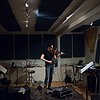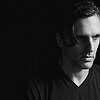Name: Christopher Tignor
Nationality: American
Occupation: Violinist/ Composer/ Software Engineer
Bands/ Projects: Slow Six, Wires.Under.Tension
Current Releases: Along a Vanishing Plane on Western Vinyl
Musical Recommendations: Any video on the Sacred Harp Singers of Cork YouTube channel. An inspirational way to create music. Daniel Wohl’s, Holographic (New Amsterdam) is beautiful chamber music / electro-alchemy.
Website: wiresundertension.com
When did you start composing - and what or who were your early passions and influences?
I was in various arty rock bands and experimented in the electronic music studio through college but it wasn’t until shortly thereafter that I engaged in anything I’d call composing. I’d started building interactive music software using Max/MSP and my professor Richard Teitelbaum, a seminal electronic music pioneer, took me under his wing. Basically I made music software for his works and traveled around doing a bunch of shows with him running the tech. He didn’t know a thing about computers but was keen on my wild, young-man passion for keeping everything live with real-time processing. I really learned how to build interactive software during this time for some big concerts at a young age.
Aesthetically, however, my head and heart were in a different place. The day my violin teacher gave me Arvo Pärt’s Fratres (the 1980 violin / piano version) was when I thought to myself, “Hey, here’s a modern compositional voice that actually feels like my own”.
After moving to the city I got a job working for La Monte Young and Marian Zazeela. I got to mind their Dream House installation on the floor above their Tribeca Loft, and I spent a lot of time up there with the drones and gorgeous colored shadows. Mostly I was their manservant, preparing meals they’d meticulously designed, picking up laundry, dusting off humidifiers and the like. I got to overhear some decent conversations and some great Raga while immersing myself into all the physical recordings and books they lived among.
All the while I was staying up nights messing around on a great Mark I Fender Rhodes I found cheap. I’d write and record endless reams of Rhodes music, just letting my fingers learn what notes go best together. Eventually I expanded to other instruments I knew, like the violin and guitar, and found some folks willing to come over and knock around my truly crude notation. Of course there was always a role for live software processing of these parts and that was my role. That work evolved into Slow Six.
For most artists, originality is first preceded by a phase of learning and, often, emulating others. What was this like for you? How would you describe your own development as an artist and the transition towards your own voice?
Well, I had the unique advantage of never having had any formal composition instruction until much later in life. I never even knew anyone my age who called themselves a composer until after college. For the rest of us the whole world of music was more or less bands. As a result of having no real examples of what I wanted to do I also didn’t have shadows hanging over me. I mostly learned about modern art music by going to Other Music and Tower Records’ Classical section and buying lots of CDs. It was fantastic really, but probably the only music I heard that I connected to aesthetically were those minimalists - Reich and Pärt mostly. Between them, David Pajo’s eponymous Aerial M LP, and Dirty Three’s Horse Stories I was set. But I think even from the get go my skewed take on all that was my own and that’s also how others seemed to respond to that first Slow Six LP. It basically turned out to be outsider art for the modern classical scene.
I’d say my development has always been driven by stubbornly charging down each new avenue of interest over the years, going as deep as possible into the vision for the each project. Between Slow Six, Wires Under Tension, and my solo work I think I’ve delivered a uniquely broad range of music. I like to think that indicates an artist pushing himself into new regions, be it blending rock idioms with minimalist polyrhythms, software processed orchestral impressionism, deep ambient water coloring, etc. My discography is my best self-portrait, done in time-lapse.
What were some of the most important creative challenges when starting out as a composer and how have they changed over time?
The most important challenges are absolutely mundane and never change: how to get all the right notes into the right place at the right time for example! I think I’ve always known what the “right” notes felt like but when I first started that range of knowing was much, much more limited. That’s a skill you develop as a composer: broadening your range for feeling when something works and maybe even why it works. I’d say my problem now is that, where before there was always only one clear path, now there are many, many paths before me at every turn leading down different roads. So writing music is actually a bit harder now because I feel the need to try much more out while remaining absolutely picky with the results. Such are the hazards of swimming in the larger creative pond.
Tell us about your studio/work space, please. What were criteria when setting it up and how does this environment influence the creative process? How important, relatively speaking, are factors like mood, ergonomics, haptics and technology for you?
I built this studio in the basement of my Brownstone in Brooklyn. It required digging down 3 feet into the rock to get this ceiling height (three big dumpsters worth). Just like digging a swimming pool in your house, but then filling it with sound. A sound pool. Me and my friend built those 15 fiberglass sound panels and another sewed me all those curtains to help control the sound. It’s bordered by rock on all sides, like being buried in your own music. I love the ability to womb up down there when the rest of the world is asleep and build my own lucid dreams.
I’ve never been the type for stylized visual aesthetics in the work space. My ideal is the blank palette without visual baggage to distract from diving in deep. What inspires me is seeing the rig still set-up from the day before to pick up where I left off. “A clean, well-lighted place”. Except it’s never that clean.




